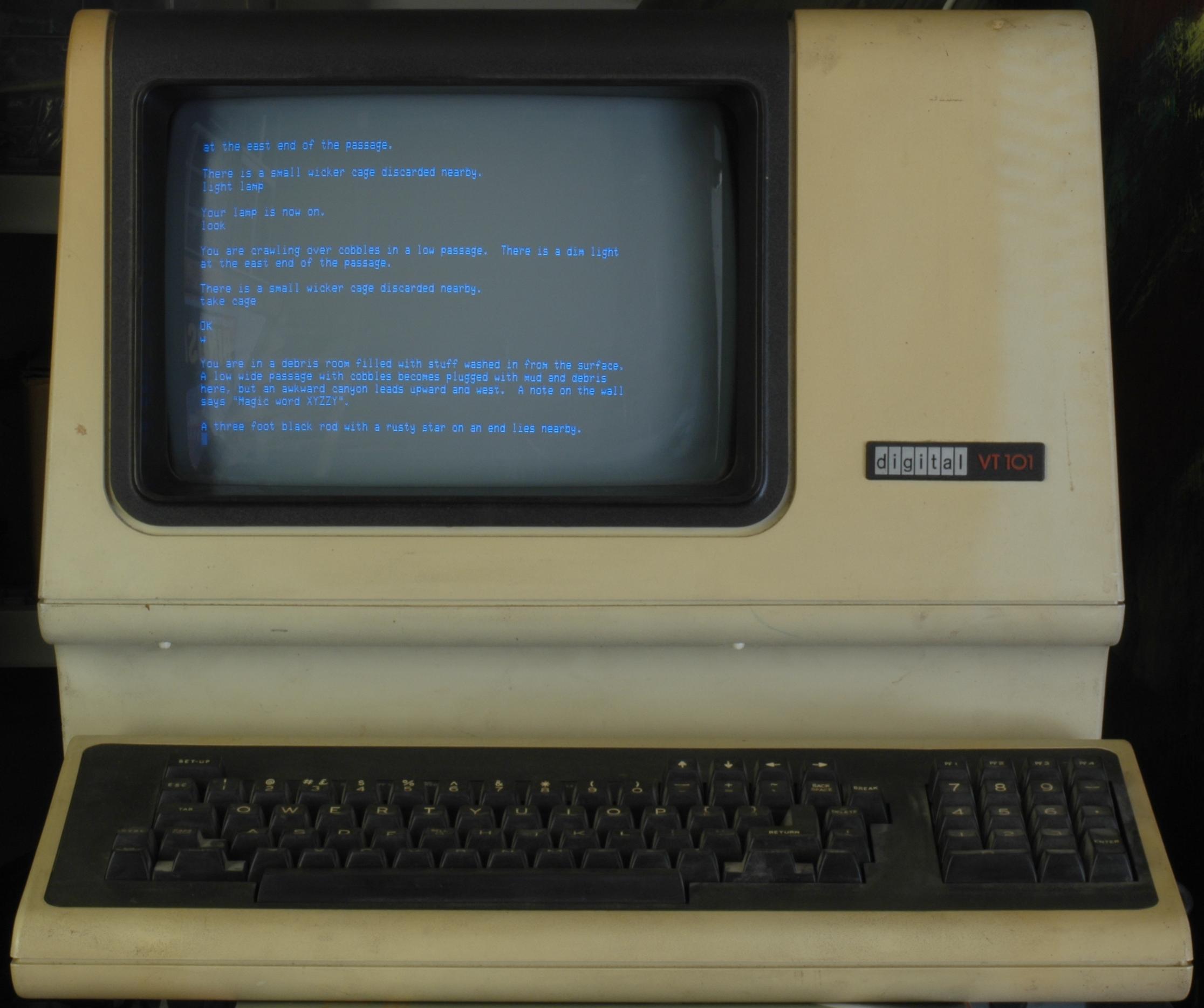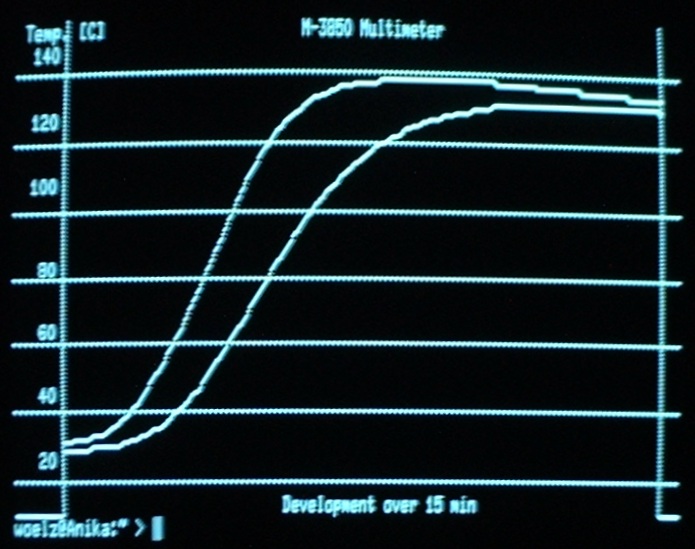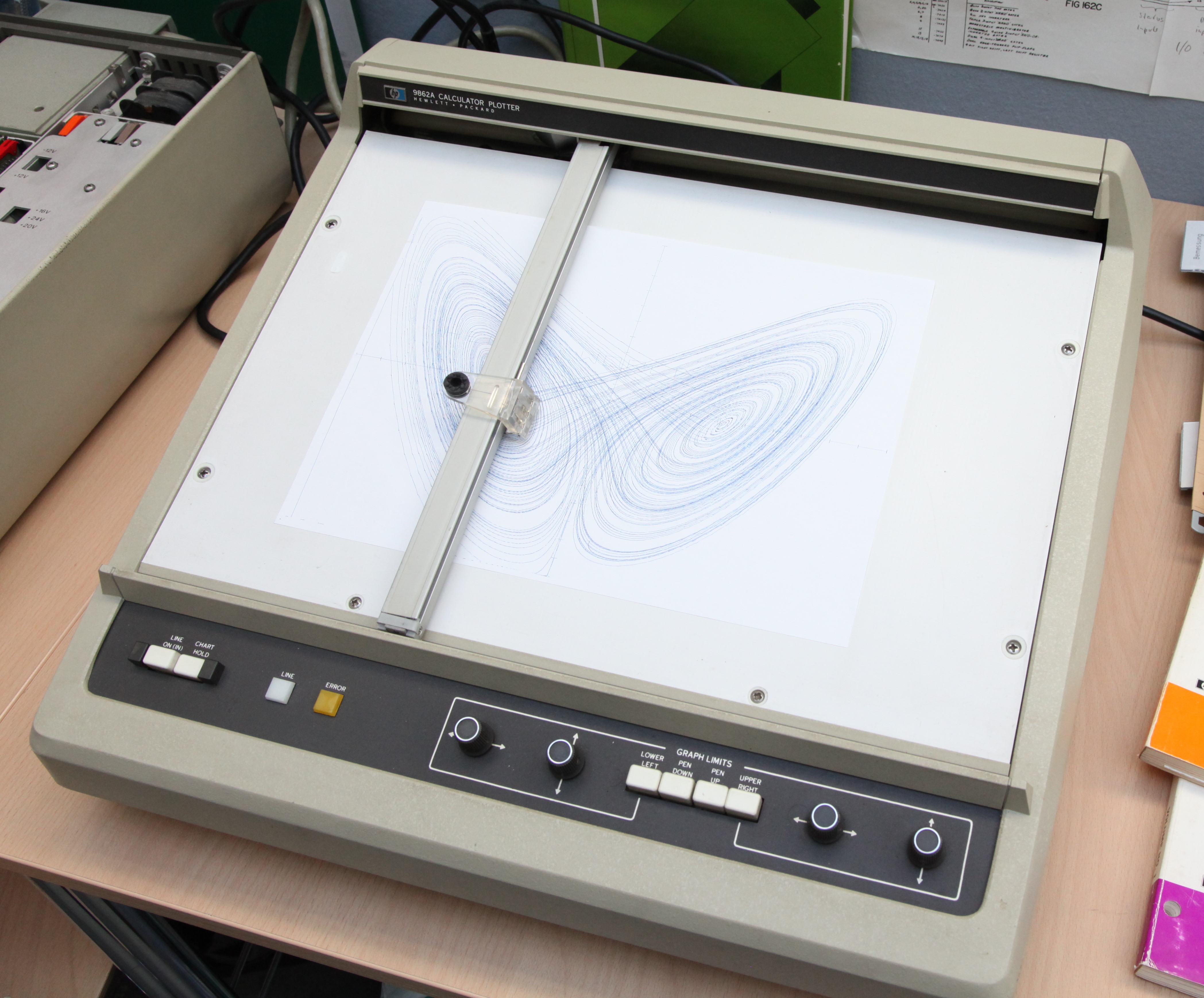|
VT50
The VT50 was a CRT-based computer terminal introduced by Digital Equipment Corporation (DEC) in July 1974. It provided a display with 12 rows and 80 columns of upper-case text, and used an expanded set of control characters and forward-only scrolling based on the earlier VT05. DEC documentation of the era refers to the terminals as the DECscope, a name that was otherwise almost never seen. The VT50 was sold only for a short period before it was replaced by the VT52 in September 1975. The VT52 provided a screen of 24 rows and 80 columns of text and supported all 95 ASCII characters as well as 32 graphics characters, bi-directional scrolling, and an expanded control character system. DEC produced a series of upgraded VT52's with additional hardware for various uses. The VT52 family was followed by the much more sophisticated VT100 in 1978. Description The VT50 supported asynchronous communication at baud rates up to 9600 bits per second and did not require any fill characters. ... [...More Info...] [...Related Items...] OR: [Wikipedia] [Google] [Baidu] |
VT100
The VT100 is a video terminal, introduced in August 1978 by Digital Equipment Corporation (DEC). It was one of the first terminals to support ANSI escape codes for cursor control and other tasks, and added a number of extended codes for special features like controlling the status lights on the keyboard. This led to rapid uptake of the ANSI standard, which became the de facto standard for hardware video terminals and later terminal emulators. The VT100 series, especially the VT102, was extremely successful in the market, and made DEC the leading terminal vendor at the time. The VT100 series was replaced by the VT200 series starting in 1983, which proved equally successful. Ultimately, over six million terminals in the VT series were sold, based largely on the success of the VT100. Description DEC's first video terminal was the VT05 (1970), succeeded by the VT50 (1974), and soon upgraded to the VT52 (1975). The VT52 featured a text display with 80 columns and 24 rows, bidir ... [...More Info...] [...Related Items...] OR: [Wikipedia] [Google] [Baidu] |
VT05
:''"VT-05" can also refer to .'' The VT05 is the first free-standing CRT computer terminal from Digital Equipment Corporation introduced in 1970. Famous for its futuristic styling, the VT05 presents the user with an upper-case-only ASCII character display of 72 columns by 20 rows. The VT05 was a smart terminal that provides cursor addressing using a series of control characters, one of which allows the cursor to be positioned at an absolute location on the screen. This basic system provided the basis of similar systems in the later and greatly improved VT50 and VT52 series. The terminal only supports forward scrolling and direct cursor addressing; no fancier editing functions are supported. No special character renditions (such as blinking, bolding, underlining, or reverse video) are supported. The VT05 supports asynchronous communication at baud rates up to 2400 bits per second (although fill characters are required above 300 bits per second). Internally, the VT05 implement ... [...More Info...] [...Related Items...] OR: [Wikipedia] [Google] [Baidu] |
Gold Key (DEC)
The Gold key is a computer keyboard key used as a prefix to invoke a variety of single-key editing and formatting functions. Usually located in the top-left position of the numeric keypad on platforms such as the VT100, it is the signature element of a consistent user interface implemented by Digital Equipment Corporation across multiple product lines. It is used within WPS, EDT, and many other common VAX programs. The key, typically located as the upper leftmost key on the numeric keypad on different terminals, was not necessarily colored gold. Some Digital Equipment Corporation (DEC) terminals would include keyboards where the gold key was labeled PF1, as on the VT100 and VT200, or was colored blue, as on the VT52. On some keyboards, the normal function of a key would be labeled on the lower portion of the key, while its alternate function activated with the GOLD key would be labeled above it. Usage The Gold Key is used to invoke single-key functions which may be located on eit ... [...More Info...] [...Related Items...] OR: [Wikipedia] [Google] [Baidu] |
Waveform Graphics
Waveform graphics is a simple vector graphics system introduced by Digital Equipment Corporation (DEC) on the VT55 and VT105 terminals in the mid-1970s. It was used to produce graphics output from mainframes and minicomputers. DEC used the term "waveform graphics" to refer specifically to the hardware, but it was used more generally to describe the whole system. The system was designed to use as little computer memory as possible. At any given X location it could draw two dots at given Y locations, making it suitable for producing two superimposed waveforms, line charts or histograms. Text and graphics could be mixed, and there were additional tools for drawing axes and markers. The waveform graphics system was used only for a short period of time before it was replaced by the more sophisticated ReGIS system, first introduced on the VT125 in 1981. ReGIS allowed the construction of arbitrary vectors and other shapes. Whereas DEC normally provided a backward compatible solution in ... [...More Info...] [...Related Items...] OR: [Wikipedia] [Google] [Baidu] |
Digital Equipment Corporation
Digital Equipment Corporation (DEC ), using the trademark Digital, was a major American company in the computer industry from the 1960s to the 1990s. The company was co-founded by Ken Olsen and Harlan Anderson in 1957. Olsen was president until forced to resign in 1992, after the company had gone into precipitous decline. The company produced many different product lines over its history. It is best known for the work in the minicomputer market starting in the mid-1960s. The company produced a series of machines known as the PDP line, with the PDP-8 and PDP-11 being among the most successful minis in history. Their success was only surpassed by another DEC product, the late-1970s VAX "supermini" systems that were designed to replace the PDP-11. Although a number of competitors had successfully competed with Digital through the 1970s, the VAX cemented the company's place as a leading vendor in the computer space. As microcomputers improved in the late 1980s, especially w ... [...More Info...] [...Related Items...] OR: [Wikipedia] [Google] [Baidu] |
Control Character
In computing and telecommunication, a control character or non-printing character (NPC) is a code point (a number) in a character set, that does not represent a written symbol. They are used as in-band signaling to cause effects other than the addition of a symbol to the text. All other characters are mainly printing, printable, or graphic characters, except perhaps for the "space" character (see ASCII printable characters). History Procedural signs in Morse code are a form of control character. A form of control characters were introduced in the 1870 Baudot code: NUL and DEL. The 1901 Murray code added the carriage return (CR) and line feed (LF), and other versions of the Baudot code included other control characters. The bell character (BEL), which rang a bell to alert operators, was also an early teletype control character. Control characters have also been called "format effectors". In ASCII There were quite a few control characters defined (33 in ASCII, and the E ... [...More Info...] [...Related Items...] OR: [Wikipedia] [Google] [Baidu] |
Cathode Ray Tube
A cathode-ray tube (CRT) is a vacuum tube containing one or more electron guns, which emit electron beams that are manipulated to display images on a phosphorescent screen. The images may represent electrical waveforms ( oscilloscope), pictures ( television set, computer monitor), radar targets, or other phenomena. A CRT on a television set is commonly called a picture tube. CRTs have also been used as memory devices, in which case the screen is not intended to be visible to an observer. The term '' cathode ray'' was used to describe electron beams when they were first discovered, before it was understood that what was emitted from the cathode was a beam of electrons. In CRT television sets and computer monitors, the entire front area of the tube is scanned repeatedly and systematically in a fixed pattern called a raster. In color devices, an image is produced by controlling the intensity of each of three electron beams, one for each additive primary color (red, gre ... [...More Info...] [...Related Items...] OR: [Wikipedia] [Google] [Baidu] |
Plotter
A plotter is a machine that produces vector graphics drawings. Plotters draw lines on paper using a pen, or in some applications, use a knife to cut a material like vinyl or leather. In the latter case, they are sometimes known as a cutting plotter. In the past, plotters were used in applications such as computer-aided design, as they were able to produce line drawings much faster and of a higher quality than contemporary conventional printers. Smaller desktop plotters were often used for business graphics. Printers with graphics capabilities took away some of the market by the early 1980s, and the introduction of laser printers in the mid-1980s largely eliminated the use of plotters from most roles. Plotters retained a niche for producing very large drawings for many years, but have now largely been replaced by wide-format conventional printers. Cutting plotters remain in use in a number of industries. Overview Digitally controlled plotters evolved from earlier fully an ... [...More Info...] [...Related Items...] OR: [Wikipedia] [Google] [Baidu] |
Tektronix 4010
The Tektronix 4010 series was a family of text-and-graphics computer terminals based on storage-tube technology created by Tektronix. Several members of the family were introduced during the 1970s, the best known being the 11-inch 4010 and 19-inch 4014, along with the less popular 25-inch 4016. They were widely used in the computer-aided design market in the 1970s and early 1980s. The 4000 series were much less expensive than earlier graphics terminals, such as the IBM 2250, because no additional electronics were needed to maintain the display on the storage-tube screen; images drawn to the screen remained there until deliberately erased. This eliminated the need for computer memory to store the images, which was extremely expensive in the 1970s. The display series remained popular until the introduction of inexpensive graphics workstations in the 1980s. These new graphics workstations used raster displays and dedicated screen buffers that became more affordable as solid-stat ... [...More Info...] [...Related Items...] OR: [Wikipedia] [Google] [Baidu] |
Histogram
A histogram is an approximate representation of the frequency distribution, distribution of numerical data. The term was first introduced by Karl Pearson. To construct a histogram, the first step is to "Data binning, bin" (or "Data binning, bucket") the range of values—that is, divide the entire range of values into a series of intervals—and then count how many values fall into each interval. The bins are usually specified as consecutive, non-overlapping interval (mathematics), intervals of a variable. The bins (intervals) must be adjacent and are often (but not required to be) of equal size. If the bins are of equal size, a bar is drawn over the bin with height proportional to the Frequency (statistics), frequency—the number of cases in each bin. A histogram may also be normalization (statistics), normalized to display "relative" frequencies showing the proportion of cases that fall into each of several Categorization, categories, with the sum of the heights equaling 1. ... [...More Info...] [...Related Items...] OR: [Wikipedia] [Google] [Baidu] |
WYSIWYG
In computing, WYSIWYG ( ), an acronym for What You See Is What You Get, is a system in which editing software allows content to be edited in a form that resembles its appearance when printed or displayed as a finished product, such as a printed document, web page, or slide presentation. WYSIWYG implies a user interface that allows the user to view something very similar to the end result while the document is being created. In general, WYSIWYG implies the ability to directly manipulate the layout of a document without having to type or remember names of layout commands. History Before the adoption of WYSIWYG techniques, text appeared in editors using the system standard typeface and style with little indication of layout ( margins, spacing, etc.). Users were required to enter special non-printing ''control codes'' (now referred to as markup ''code tags'') to indicate that some text should be in boldface, italics, or a different typeface or size. In this environment there was very ... [...More Info...] [...Related Items...] OR: [Wikipedia] [Google] [Baidu] |
Convection
Convection is single or multiphase fluid flow that occurs spontaneously due to the combined effects of material property heterogeneity and body forces on a fluid, most commonly density and gravity (see buoyancy). When the cause of the convection is unspecified, convection due to the effects of thermal expansion and buoyancy can be assumed. Convection may also take place in soft solids or mixtures where particles can flow. Convective flow may be transient (such as when a multiphase mixture of oil and water separates) or steady state (see Convection cell). The convection may be due to gravitational, electromagnetic or fictitious body forces. Heat transfer by natural convection plays a role in the structure of Earth's atmosphere, its oceans, and its mantle. Discrete convective cells in the atmosphere can be identified by clouds, with stronger convection resulting in thunderstorms. Natural convection also plays a role in stellar physics. Convection is often categor ... [...More Info...] [...Related Items...] OR: [Wikipedia] [Google] [Baidu] |





